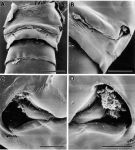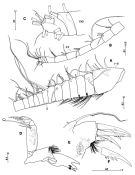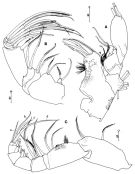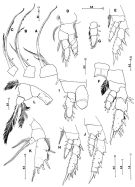|
|
 |
Fiche d'espèce de Copépode |
|
|
Calanoida ( Ordre ) |
|
|
|
Arietelloidea ( Superfamille ) |
|
|
|
Arietellidae ( Famille ) |
|
|
|
Crassarietellus ( Genre ) |
|
|
| |
Crassarietellus huysi Ohtsuka, Boxshall & Roe, 1994 (F) | |
| | | | | | | Syn.: | ? Crassarietellus sp. (M) Ohtsuka & al., 1994 (p.116, figs.M) | | | | Ref.: | | | Ohtsuka & al., 1994 (p.109, Descr.F, figs.F, Rem.M); Boxshall & Halsey, 2004 (p.63: fig.F) |  issued from : S. Ohtsuka, G.A. Boxshall & H.S.J. Roe in Bull. nat. Hist. Lond. (Zool.), 1994, 60 (2). [p.110, Fig.1]. Female (off W Africa): A, habitus (dorsal); B, idem (lateral left side); G, urosome (ventral); D, genital double-somite (ventral); E, idem (lateral ); F, A2 (one terminal seta on 2nd endopod segment missing); G, terminal part of 2nd endopod of other A2. Scale bars in mm. Nota: Cephalosome and 1st pedigerous somite separate, 4th and 5th fused. Urosome 4-segmented. Anal somite small, anal operculum not developed. Caudal rami loner than wide, fringed with long setules along inner margin, with vestigial seta I and developed setae II to VI, seta VII originating dorsally nera base of seta VI (Fig.1C); inner margin near anus with patch of minute spinules. Integument of body and appendages pitted. A2 with coxa unarmed; basis with spinulose seta at inner angle; endopod 2-segmented, 1st segment with minute seta at 3/4 length, covered with minute spinules distally, 2nd segment with 3 setae of unequal lengths medially and 5 setae distally and sparsely covered by spinules; exopod indistinctly 10-segmented, 2nd to 4th segments almost fused (setal formula: 0, 0, 0, 1, 1, 1, 1, 1, 0, 3, respectively), 9th segment sparsely ornamented with minute spinules.
|
 issued from : S. Ohtsuka, G.A. Boxshall & H.S.J. Roe in Bull. nat. Hist. Lond. (Zool.), 1994, 60 (2). [p.111, Fig.2]. Female (SEM micrographs): A, genital double somite (ventral; arrows indicating positions of copulatory pores); B, gonopore and copulatory pore (indicating by arrow); C, right gonopore; D, left gonopore (with remnant of spermatophore). Scale bar: 0.200 mm (A); 0.100 mm (B); 0.030 mm (C-D). Holotype: F-G; parattype: A-E.
|
 issued from : S. Ohtsuka, G.A. Boxshall & H.S.J. Roe in Bull. nat. Hist. Lond. (Zool.), 1994, 60 (2). [p.113, Fig.4]. Female: A, A1 (segments I to XV; B, idem (segments XVI to XXVIII); C, idem (segments XXII to XXVIII); D, Md; E, praecoxal arthrite and coxal endite of Mx1; F, proximal spine on praecoxal arthrite of Mx1. Scale bars in mm. Holotype: E,F; paratype: A-D. Nota: A1 equal in length, distinctly 22-segmented, reaching to posterior end of 2nd pedigerous somite; distal 2 segments incompletely fused. Md with ganthobase heavily chitinized, ventromedial margin with dense fringe of long setules, cutting ede with 3 acute teeth (dorsalmost of which bifid at tip), 2 patches of dagger-like spinules present dorsally, tuft of long setules present medially on kno; basis of palp with patches of minute spinules and row of long setules proximally (almost missing in Fig.4D); endopod rudimentary, 1-segmented, with 2 plumose setae of unequal lengths; exopod 5-segmented (almost completely separate), 1st to 4th segments each with 1 seta, terminal segment with 2 setae (one of which thinner and shorter than other), 2nd segment with patch of minute spinules. Mx1 with praecoxal arthrite with 5 stout spines (2 of which bearing 2 rows of strong spinules, and 1 process; patch of long setules and numerous minute spinules of various sizes along inner margin and patch of fine prominences along outer margin.
|
 issued from : S. Ohtsuka, G.A. Boxshall & H.S.J. Roe in Bull. nat. Hist. Lond. (Zool.), 1994, 60 (2). [p.114, Fig.5]. Female: A, Mx1 (arrowhead indicating endite seta of basis); B, Mx2; C, Mxp the armature elements on the 6th endopod segment are identified individually by the letters a to d). Scale bars in mm. Holotype: C; paratype: A-B. Nota: Mx1 coxal epipodite with 6 setae; coxal endite with elongate, spinulose seta terminally; basis with minute enditic seta (arrowhead in fig.5A) and row of long, fine setules along inner margin; endopod rudimentary, 1-segmented, bearing 2 spinulose setae of unequal lengths distally; exopod lamellar, with 3 long, plumose setae distally. Mx2 stout, with 1st praecoxal endite with 2 spinulose setae and vestigial element; 2nd praecoxal and both coxal endites each carrying 2 spinulose setae; basal endite with long, subterminal spine with 2 rows of spinules medially; endopod 4-segmented, 1st segment with 1 spinulose seta, 2nd to 4th segments with 3, 2, and 2 long spinulose setae, respectively. Syncoxa of Mxp with 1 medial and 2 subterminal setae and patch of fine spinules subterminally; basis bearing 2 patches of spinules proximally and midway along inner margin and 2 spinulose subterminal setae; endopod 6-segmented, 1st segment incompletely fused with basis, 1st to 6th segment with 1, 4, 4, 3, 3, 4 setae, respectively; 6th segment with setae a and b well developed, seta c chitinized, bering row of simple spinules along inner margin, seta d long, with inner row of simple spinules.
|
 issued from : S. Ohtsuka, G.A. Boxshall & H.S.J. Roe in Bull. nat. Hist. Lond. (Zool.), 1994, 60 (2). [p.115, Fig.6]. Female: A, 2nd endopod segment of Mxp; B, 3rd endopod segment of Mxp (innermost seta indicated by arrowhead); C, 4th endopod segment of Mxp (innermost seta indicated by arrowhead); D, P1 (anterior); E, P2 (posterior); F, aberrant P3 (anterior); G, right endopod of P3 (anterior); H, another aberrant P3 (posterior); I, extremely aberrant P3 (anterior); J, P4 (posterior); K, left P5 (anterior); L, right P5 (anterior). Scale bars in mm. Holotype: A-C, J-L. Nota: Both legs of P5 almost symmetrical; right and left coxae incompletely separate from intercoxal sclerite; basis with relatively narrow base, with plumose deta at outer angle; endopod small, 1-segmented, distinctly separate from basis, with inner medial and terminal plumose seta; exopod indistinctly 3-segmented, each almost fused, 1st and 2nd segment with serrate spine at outer angle, 3rd with 2 terminal and 1 lateral spines. Remarks: P3 with several aberrations: extra spine present on each of 1st (Fig.6F) and 3rd exopod segments (Fig.6F,H); extra seta on 1st (Fig.6H) and 2nd endopod segments (Fig.6F); fewer seta on 3rd endopod segment (Fig.6F); both rami extremely abnormal (Fig.6,I). The paratypic females have aberrant P3 (Fig.6F,H,I). Both paratypes have 4 outer spines on the 3rd exopodal segment, but it is likely that the segment normally has 3 outer spines, because the males of Crassarietellus sp. and other arietellids carry only 3 spines on this segment. An additional spine on the 1st exopodal segment of P3 has also been reported in specimens of some shallow-water hyperbenthic and cave-dwelling species of the calanoid family Pseudocyclopiidae. The presence of a seta on the outer margin of the 2nd endopodal segment of P3 is unique for the Calanoida.
| | | | | Ref. compl.: | | | Bradford-Grieve, 2004 (p.283) | | | | NZ: | 1 | | |
|
Carte de distribution de Crassarietellus huysi par zones géographiques
|
| | | | Loc: | | | NE Atlant. (off N Cape Verde Is.)
Type locality: 20°8.5'N, 21°1.2'W. | | | | N: | 1 | | | | Lg.: | | | (263) F: 3,88; 3,85; {F: 3,85-3,88} | | | | Rem.: | hyperbenthique (± 4000 m) | | | Dernière mise à jour : 05/12/2014 | |
|
|
 Toute utilisation de ce site pour une publication sera mentionnée avec la référence suivante : Toute utilisation de ce site pour une publication sera mentionnée avec la référence suivante :
Razouls C., Desreumaux N., Kouwenberg J. et de Bovée F., 2005-2025. - Biodiversité des Copépodes planctoniques marins (morphologie, répartition géographique et données biologiques). Sorbonne Université, CNRS. Disponible sur http://copepodes.obs-banyuls.fr [Accédé le 27 août 2025] © copyright 2005-2025 Sorbonne Université, CNRS
|
|
 |
 |








